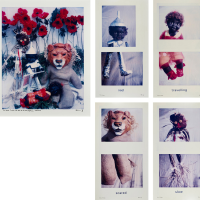23. DESTINY DEACON

Since the late 1980s, Destiny Deacon has blazed an extraordinary trail to become one of Australias most prominent contemporary artists. Deacon modestly describes herself as just an old-fashioned political artist1; however her installations, videos and photographic prints have been included in many prestigious international exhibitions including the fifth Havana Biennale in 1994, the first Johannesburg Biennale in 1995, and the Yokohama Triennale in 2001. In 2002, Deacon was the only Australian artist to be chosen for Documenta 11. Like Tracey Moffatt, she is one of few contemporary Australian artists to have established an international audience. Her work is represented in all of Australias major national and state gallery collections.
As a descendant of the Kuku (Cape York) and Erub/Mer (Torres Strait) people, Deacon employs her satirical blak humour to reimagine the Aboriginal narrative and challenge the engrained racism of contemporary Australia. To create her images, Deacon stages scenes using her friends and family as models or drawing from her copious collection of Aboriginalia consisting of black dollies and kitsch, op shop effigies. The resulting images question the historical representations of Indigenous people, the playful appearance of the dolls and found objects overshadowed by the serious concerns of her work. The visually appealing, colourful photographs displace the difficulty of many of her subjects, enabling complex themes (including Aboriginal deaths in custody, mandatory sentencing, poverty, and violence) to become more palpable and consequently more affecting. As Deacon says of her work, I like to think there is a laugh and a tear in every picture.2
Deacons Oz Series parodies the 1939 film The Wizard of Oz, interpreting the central characters in her idiosyncratic way using old-fashioned dolls. Each figure is formed from two separate, greatly enlarged Polaroids, and titled for the characters attributes: Dorothy travelling through Oz in her gifted ruby slippers to find her way home, the sad Tinman without a heart, the slow scarecrow without a brain, and the scared lion without courage. These personae are characterised by their dissatisfaction with their perceived personal weaknesses, over which they eventually triumph. The journey resembles the adversity and quest for self-realisation that many Aboriginal people face every day. Curator Judy Annear summarises, Through her tableaux of assembled Koori kitsch dolls, performing in-character the roles handed to them, Deacon demonstrates how the construction of identity is an old game and one that she can play too.3
Oz Games (Under the Spell of the Tall Poppies) uses the same slapdash figures to reconstruct the famous scene where the main characters are lulled to sleep by the intoxicating scent of a field of poppies (an allusion to the poppys derivative, opium). In Australian history however, the red poppy is inextricably linked to Remembrance Day, when it is used to commemorate soldiers killed at war. As these works were created in the leadup to the 2000 Sydney Olympic Games, the symbolic poppy is also a reference to the disparaging way in which Australian society treats successful people, commonly known as tall poppy syndrome. In this context, Deacons image is a comical reminder of Australias problematic self-identity.
Although Deacon describes herself as just a crappy artist,4 it is clear that she is a master at work, imbuing every eye-catching image with multifaceted meaning. Her humble approach to making art is at odds with her oeuvre which is characterised by complexity, intellect, and wit. Acknowledged as one of her most iconic series, the present lot represents the most significant example of the artists work to come to auction to date.
Footnotes:
1. Fink, H., Destiny Deacon, Tradition Today: Indigenous Art in Australia, Art Gallery of New South Wales, Sydney, 2013 (accessed September 2022): https://www.artgallery.nsw.gov.au/collection/artists/deacon-destiny/
2. Destiny Deacon, quoted in Not Much of a Soul to Bare: Interview with Virginia Fraser, in Destiny Deacon: Walk & Don't Look Blak, Museum of Contemporary Art, Sydney, 2004, p.110
3. Annear, J., Photography Collection Handbook, Art Gallery of New South Wales, Sydney, 2007, n.p.
4. Fink, H., op. cit.
Asta Cameron